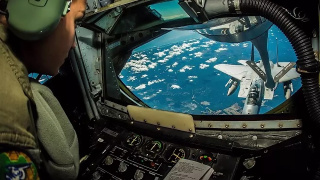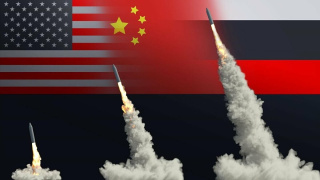U.S. Openly Militarizes Space
In early August 2023, the United States Space Force (USSF) published its Space Doctrine Publication (SDP) 3-0, Operations, a guide for conducting operations in the space domain.
The document is the USSF first fundamental plan of action more clearly outlining USSF specific goals, such as “offensive” and “defensive” space operations, in addition to the relatively new paradigm of “Space Mobility & Logistics (SM&L)”.
The U.S. media have noticed that the new USSF Doctrine is more focused on aligning space activity with the twelve principles of warfare as a whole, as detailed in the top-level doctrine of the Joint Chiefs of Staff’s JP 3-0, Joint Campaigns and Operations published June 18, 2022, rather than seeking direct alignment with the doctrine for joint space operations.
It is in fact based on the Space Doctrine Note, Operations, which was released in January 2023.
It should be noted that the January document also covers international specialized partnerships of the United States, including:
– The Five Eyes (FVEY) Intelligence Alliance;
– Combined Space Operations Initiative, including the U.S., Australia, the United Kingdom, Canada, New Zealand, France, and Germany;
– North Atlantic Treaty Organization (NATO);
– Japan and the U.S. Alliance;
– South Korea and U.S. Alliance; and
– Responsive Space Capabilities (RSC) MOUs with the United Kingdom, Canada, Australia, New Zealand, Germany, Italy, Norway, Spain and Sweden.
Yet, the new full-blown doctrine is more focused on the U.S. military power they are ready to deploy in outer space.
It says that: “The projection of combat power, as space combat power, includes offensive and defensive military force (fires and protection) in, from, or to the space domain (including navigation warfare).
Offensive space operations attack the adversary in, from, or to space. These operations seek to impose cost on the adversary, compel a change in behavior, secure a position of advantage, or deny the adversary’s military forces freedom of action.
Defensive space operations seek to repel or defeat adversary attacks in, from, or to the space domain. These operations aim to maintain status quo, regain the initiative, deny the adversary a position of advantage, or protect freedom of action of friendly forces. The distinction between offensive and defensive operations is not always clear…
In planning, Guardians consider offensive and defensive fires in terms of which side is attempting to retain or exploit the initiative (offense) and which side is responding to the adversary’s initiative (defense). All combat operations should include elements of offense and defense unified into coherent action to achieve desired effects.”
The document also contains the first official definition of “Space Mobility and Logistics,” a space-specific approach to what is known as “manoeuvre” in joint operations.
“Space mobility and logistics, also referred to as SAML, supports joint space operations sustainment through spacelift, satellite operations, force reconstitution, maintenance of a force of space operations personnel, and support to human space flight… Mobility (movement and maneuver) includes post-launch transport of space vehicles between orbits, within orbits, and augmented maneuvering to enhance mission effectiveness or maneuvering related to reconstitution, operational degradation or loss, and end-of-life actions. In the future, logistics on-orbit may include spacecraft servicing, disposition, debris management capabilities, refueling, and in-space component installation.”
It should be reminded that the funding for the U.S. Space Forces was budgeted at $24.5 billion in 2023, implying a serious interest in these issues.
Furthermore, the new doctrine repeatedly emphasizes the necessity of countering the anti-satellite systems of Russia and China, as goes the section on competition, which has not escalated into an armed conflict yet. That is, it means the current actual moment.
Maj. Gen. Gregory J. Gagnon, Deputy Chief of Space Operations for Intelligence, U.S. Space Force, admitted in August 2023 that half of what they did was then focused on China, 25% on Russia and the remaining part on the rest of the world or the commercial sector.
The USSF currently employs more than 1,500 space intelligence experts, he said, and at the heart of its intelligence operations is the National Space Intelligence Center (NSIC), also known as Space Delta 18, which was launched by the Space Command at Wright Patterson Air Force Base in Dayton, OH in June 2022.
With regard to direct military operations, the doctrine states that “space operations in the context of an armed conflict include all types of actions conducted across the cooperation and competition continuum, if possible. In addition, an armed conflict implies reversible and irreversible consequences for the defense of the United States and space capabilities of their allies and partners (defensive space operations), denying opponents freedom of action in, from, or to the space domain (offensive space operations). In an armed conflict/war, spacepower represents forces as part of the joint forces conducting operations across all domains. Spacepower can provide the joint forces with a simultaneous and rapid attack on key nodes and forces, resulting in effects that can overwhelm the adversary’s ability to adapt or recover.”
We should also mention a number of concepts that make the doctrine’s goals and objectives clearer.
“Space Domain Awareness (SDA) is a timely, relevant and actionable understanding of the operational environment that enables military forces to plan, integrate, execute and evaluate space operations. It encompasses knowledge of the systems or actions of a potential adversary, as well as an understanding of the adversary’s intentions or likely response to an event.
SDA contributes to the security and economy of the United States, its allies and partners. SDA employs a unique subset of intelligence, reconnaissance and surveillance related to environmental monitoring and data exchange mechanism that provides operators and decision makers with timely information about all factors (including policy and strategy) and actors (friendly, hostile and third parties) affecting or potentially affecting space operations.”
Therefore, it is clear that the United States Space Force is supporting Ukraine in collecting intelligence on the positions of Russian troops, as well as in monitoring all actions and movements inside Russia (and in other states). Since it notes political factors, as well as friendly and third parties, it says that the United States is constantly spying on everyone without exception and is ready to take action if it deems it necessary to do so.
It also interprets other concepts that have migrated from earlier documents. Their abundance clues the militaristic thinking of the authors and the U.S. military-political community as a whole.
In practice, the USSF intends to actively militarize the space domain in the coming years. As outlined in Operational Imperative 1: Space Order of Battle published in July 2023, the Space Force’s primary solution is proliferation — more satellites in more orbits. Instead of a few provocative targets, the USSF will deploy a mesh network of hundreds, if not thousands, of satellites in orbits, making the task of destroying such a constellation too big and too complex to even consider this.
The Space Development Agency (SDA) has proposed the Proliferated Warfighter Space Architecture (PWSA) for this purpose. By fielding hundreds of LEO satellites, the SDA aims to increase the number of USSF satellites by at least four to six times by the end of the decade.
In April 2023, the SDA launched the first of its 28 Tranche 0 satellites for its constellation, with 150 Tranche 1 satellites scheduled to arrive starting in 2024. Tranche 2 encompasses more than 250 satellites, the launches to begin in 2026.
The Space Systems Command (SSC), in turn, is developing a robust MEO missile warning/tracking constellation of at least 36 satellites. They will be launched in stages, or milestones, with nine spacecraft in the first round.
They will be fielded in various orbits, i.e., low (LEO), medium (MEO) and elliptical orbits, such as a polar (halo) orbit, which, according to the plan, should enhance the stability of the U.S. satellite network.
We should also pay attention to the theory of “Competitive Endurance”, which was presented in March 2023 by Gen. Chance Saltzman, Chief of Space Operations in the U.S. Space Force. He said, “The goal of this theory of success is to maximize our ability to deter a crisis or conflict from extending into space and, if necessary, allow the joint force to achieve space superiority while also maintaining the safety, security, and long-term sustainability of the space domain.” It has three core tenets: 1) be prepared for any surprises, that is, have a comprehensive understanding of, and be able to detect and preempt any shifts in the operational environment that could compromise the ability of the joint force to achieve space superiority in the space domain; 2) shift the balance by making an attack on satellites impractical and self-defeating, thus discouraging an adversary from taking such actions in the first place; and 3) run counterspace activities to prevent adversaries from leveraging space-enabled targeting to attack the U.S. military forces.
“Space forces must preserve U.S. advantages by campaigning through competition without incentivizing rivals to escalate to destructive military activities in space,” Saltzman said. However, it is doubtful that other countries against whom the U.S. is accumulating military force and whom it openly calls a threat will calmly watch the growing U.S. capabilities without developing their own. Meanwhile, there are open talks about the proliferation regime, in contrast to the non-proliferation regime, which is the U.S. stance on nuclear weapons.












